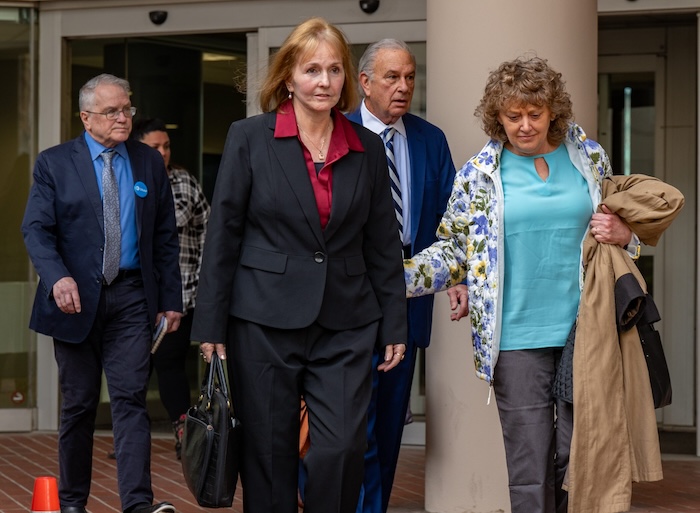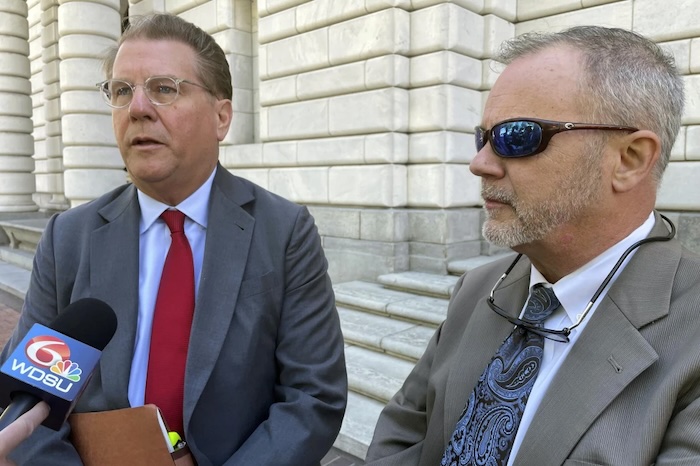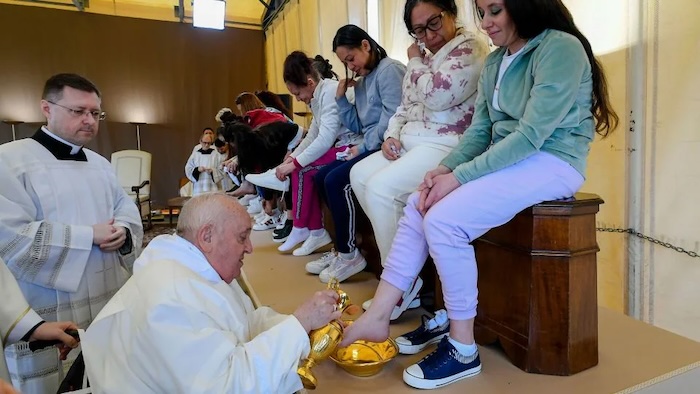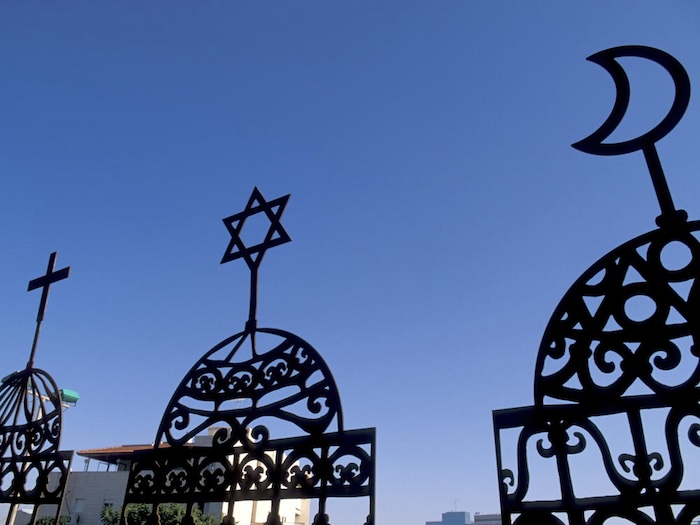
Six victim-survivors of sexual abuse by clergy in the Archdiocese of Baltimore gave statements in court April 8 about the long-term impact of the abuse on their lives as part of the federal bankruptcy reorganization.
The testimonies were off the record and not transcribed. Judge Michelle M. Harner, who is overseeing the Chapter 11 case, noted that the statements are not evidentiary in the case.
Their primary purpose, she said, was to “increase engagement and understanding” and to provide a forum for those affected by the pre-bankruptcy conduct of the archdiocese and its representatives.
“Today is a listening session and an opportunity for individuals to be heard,” Harner said.
Archbishop William E. Lori and Auxiliary Bishop Adam J. Parker attended the hearing, sitting in the front of the courtroom. They both hugged the first survivor who spoke.

Harner thanked each person who made a statement — three women and three men — for their participation in the process. About 50 people attended the hearing at the federal courthouse in Baltimore.
Some of those who spoke to the court specifically addressed the archbishop. In one poignant moment, one of the victim-survivors also turned to address other victim-survivors in court, reminding them that as adults, they can take control of their healing.
Some common themes emerged in the victim-survivors’ statements — further abuse, troubled marriages and divorces, issues of trusting anyone, and other problems that have plagued their lives. Some noted that the chance to bring their experience to the court would be an important part of their healing.
In one touching moment, during one victim-survivor’s statement, the woman who was first to speak reached over the handrail to hold the hand of her husband, sitting just behind her.
The session, scheduled for two hours, ended after just an hour. Another such session is scheduled for May 20, which Archbishop Lori also will attend.
Paul Jan Zdunek, who chairs the Unsecured Creditors Committee, a group of seven people who represent all the victim-survivors in the case, said after the session that he was surprised at how quickly the session went, “despite it didn’t feel that way. I thought everyone was really great with their words and their preparation and the courage that it took to do that in front of everybody.”
He said he appreciated that the judge supported the process and allowed each participant to have the time they needed to tell their story.
“We even heard from them that this was a healing moment and a moment they’ve been waiting for in some cases 50 years, which is extraordinary. I think what struck me today was beyond the moments that happened when they were children, how much it has affected them since, you know, 50 years ago, 60 years of a life gone,” Zdunek told the Catholic Review, Baltimore’s archdiocesan news outlet.
He said he was not surprised to hear that many of those who spoke have issues trusting others, especially because the abuse happened in a church or school by someone who was supposed to minister to them. “Here it is the one place that you’re supposed to be safe and have been told, you know, as a Catholic raised myself, that this is the truth, the light, the way, the place for salvation — and to have that be the place that trust leaves you is devastating,” Zdunek said.
In advance of the hearing, he said the members of the survivors committee — five of whom attended the hearing — purposely wanted to allow others not on the committee to have the first opportunity to speak in court. He said that in this process, the committee already has the ear of the archbishop. “We thought it was important for others to really have the chance to speak.”
He expects the May 20 hearing to be similar. “He wanted to see how this went first, but I’d imagine it’s not going to be too much different than this.”
The deadline to file a claim in the case is May 31.

Teresa F. Lancaster, one of those who spoke in court, addressed reporters after the hearing and noted that she had testified in support of the Child Victims Act passed by the Maryland General Assembly in 2023, which removed the statute of limitations for civil suits for child sexual abuse.
She acknowledged that abuse has happened not just in the church, but also in other schools and organizations.
Asked whether her day in court was a day that she has long been waiting for, Lancaster, who eventually became an attorney so she could help other victims, said, “We wanted our day in court and we were deprived of it. So, I felt somewhat, and I want all the survivors to feel that, hey, your voice has been heard, you’re just as important, and people know what happened now.”
Outside the courthouse after the hearing, Archbishop Lori said he came as a pastor and priest and was moved by the testimony that he heard.
“My meetings with victim-survivors over the years have taught me the importance of their being able to tell their story, the importance of being heard and listened to, and being believed, and so I came to listen,” he said, adding that he “hopes that by doing this I can contribute in some small way to the healing of the of these individuals and what they’ve been through.”
He said that after the passage of the Child Victims Act, the archdiocese filed for Chapter 11 reorganization “so that we could, in fact, help as many victim survivors as equitably as we can while at the same time carrying forward the mission of the church, of our parishes, our charities and our schools.”
Asked if he has said he is sorry for the pain experienced by those abused, the archbishop said, “I’ve said it many times. and will say it to the end of my life. But I recognize that no apology of mine undoes what was done. Listening, believing, does a lot more.
“I’ve listened and met with victim survivors for a long, long time and every time I listen, it shakes me — every time.”
In a statement released later in the day, Archbishop Lori said, “I am deeply grateful to the victim-survivors for their courage today and I am moved by their heart-rending experience.
“To the victim-survivors who long to hear that someone is sorry for the trauma they endured and for its life-altering consequences: I am profoundly sorry. I offer my sincerest apology on behalf of the archdiocese for the terrible harm caused to them by representatives of the church,” he said. “What happened to them never should have occurred. No child should ever, ever suffer such harm.”
He added his thanks to those of Harner, saying, “I ask that the focus today be on the courage and bravery of the women and men who offered their statements and those they represent.
“Their stories and those of the victim-survivors I’ve met with privately for decades, emboldens our response and determination to ensure no child in our care is ever again harmed. I am grateful to the Survivors Committee for initiating the request to offer victim-survivors this opportunity today, which I sincerely pray will further assist them in their journey toward healing.”
The hearing comes a year and three days after the Maryland Office of the Attorney General released an extensive report on clergy sexual abuse of minors in the Archdiocese of Baltimore. Maryland Gov. Wes Moore, a Democrat, signed the Child Victims Act into law April 11, 2023. It went into effect Oct. 1, 2023.
Complete Article ↪HERE↩!







